battery SKODA FABIA 2008 2.G / 5J Owner's Guide
[x] Cancel search | Manufacturer: SKODA, Model Year: 2008, Model line: FABIA, Model: SKODA FABIA 2008 2.G / 5JPages: 252, PDF Size: 40.88 MB
Page 111 of 252
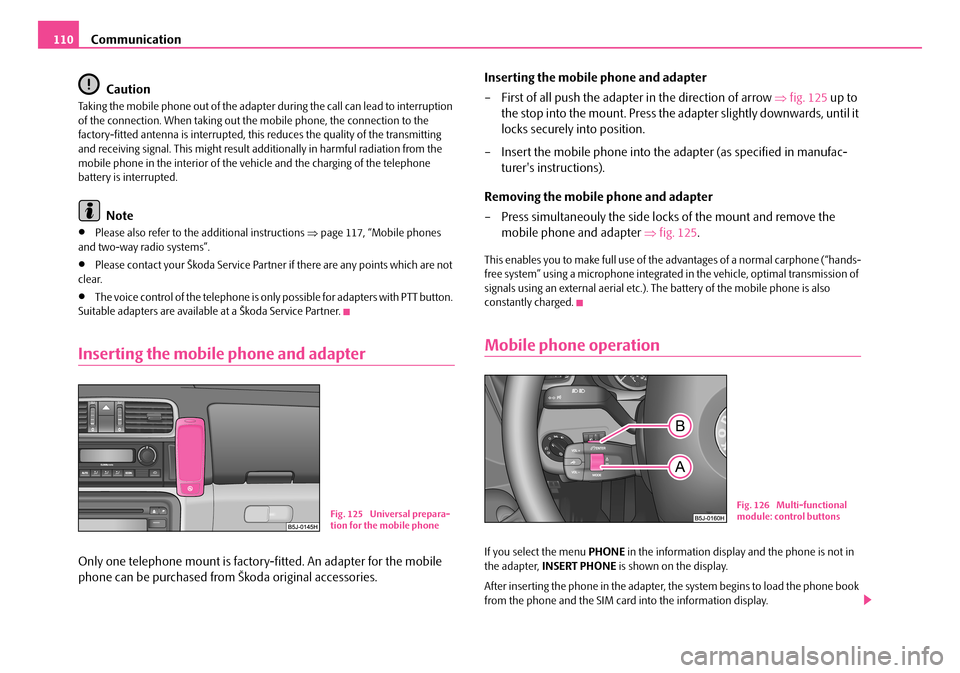
Communication110
Caution
Taking the mobile phone out of the adapter during the call can lead to interruption of the connection. When taking out the mobile phone, the connection to the factory-fitted antenna is interrupted, this reduces the quality of the transmitting and receiving signal. This might result additionally in harmful radiation from the mobile phone in the interior of the vehicle and the charging of the telephone battery is interrupted.
Note
•Please also refer to the additional instructions ⇒page 117, “Mobile phones and two-way radio systems”.
•Please contact your Škoda Service Partner if there are any points which are not clear.
•The voice control of the telephone is only possible for adapters with PTT button. Suitable adapters are available at a Škoda Service Partner.
Inserting the mobile phone and adapter
Only one telephone mount is factory-fitted. An adapter for the mobile
phone can be purchased from Škoda original accessories.
Inserting the mobile phone and adapter
– First of all push the adapter in the direction of arrow ⇒fig. 125 up to
the stop into the mount. Press the adapter slightly downwards, until it
locks securely into position.
– Insert the mobile phone into the adapter (as specified in manufac-
turer's instructions).
Removing the mobile phone and adapter
– Press simultaneouly the side locks of the mount and remove the
mobile phone and adapter ⇒fig. 125.
This enables you to make full use of the advantages of a normal carphone (“hands-free system” using a microphone integrated in the vehicle, optimal transmission of signals using an external aerial etc.). The battery of the mobile phone is also constantly charged.
Mobile phone operation
If you select the menu PHONE in the information display and the phone is not in the adapter, INSERT PHONE is shown on the display.
After inserting the phone in the adapter, the system begins to load the phone book from the phone and the SIM card into the information display.
Fig. 125 Universal prepara-tion for the mobile phone
Fig. 126 Multi-functional module: control buttons
NKO A05F 20.book Page 110 Wednesday, April 2, 2008 1:02 PM
Page 118 of 252

Communication117
Using the systemSafetyDriving TipsGeneral MaintenanceBreakdown assistanceTechnical Data
Establishing the Bluetooth connection
After switching on the ignition, the Bluetooth connection is automatically estab-lished for the already adapted mobile phone 4). You can hear an increasing tone sequence from the loudspeakers of the vehicle.
Disconnecting the Bluetooth connection
After withdrawing the ignition key, the Bluetooth connection is disonnected. You can hear an increasing tone sequence from the loudspeakers of the vehicle.
WARNING
•Pay attention primarily to the traffic situation! As the driver you are fully responsible for road safety. Use the telephone system only to such an extent, so that you are in full control of your vehicle at any time - risk of accident!
•In the event of air transport, the Bluetooth function of the handsfree-system must be switched off by a specialist garage.
Caution
Taking the mobile phone out of the adapter during the call can lead to interruption of the connection. When taking out the mobile phone, the connection to the factory-fitted antenna is interrupted, this reduces the quality of the transmitting and receiving signal. This might result additionally in harmful radiation from the mobile phone in the interior of the vehicle and the charging of the telephone battery is interrupted.
Note
•Not valid for all mobile phones which enable a communication via Bluetooth.
•Please operate your mobile phone exclusively with a suitable adapter, in order to keep a low radiation in the vehicle.
•Inserting the mobile phone into the adapter ensures an optimal sending and receiving power and offers at the same time the advantage of the battery charging.
•If you insert the mobile telephone into the adapter, the connection is estab-lished via the interface in the adapter set and the Bluetooth connection is discon-
nected. You can hear an increasing tone sequence from the loudspeakers of the vehicle.
•Note that the range of the Bluetooth connection to the handsfree-system is limited to the vehicle interior. The range is dependent on local factors, e.g. obstacles between the devices and interferences with other devices. If your mobile phone is e.g. in a jacket pocket, this can lead to difficulties when establishing the Bluetooth connection with the handsfree-system or the data transfer.
•If you have set the Portuguese language in the information display, it is used automatically for the mobile phone operation, as this is the language, which was entered during coding of the handsfree-system.
•On certain mobile phones with operating system, it is necessary to install on the mobile phone an application of the mobile phone manufacturer, which enables the take-over of the phone phonebook via Bluetooth.
Mobile phones and two-way radio systems
We recommend that you have the installation of a mobile phone and two-way radio system in a vehicle carried out by a Škoda Service Partner.
Škoda Auto a.s. permits the operation of mobile phones and two-way radio systems with a professionally installed external aerial and a maximum transmission power of up to 10 watts.
Our Škoda Service Partners are also happy to inform you about the possibilities available for installing and operating mobile telephones and radio transmitters which have an output greater than 10 watts. The Škoda Service Partners can provide you with details about the technical possibilities for retrofitting of mobile tele-phones and radio transmitters.
Operation of mobile phones or two-way radio systems may interfere with func-tioning of the electronic systems of your vehicle. The reasons for this may be:
•no external aerial,
•external aerial incorrectly installed,
•transmission power greater than 10 watts.
NKO A05F 20.book Page 117 Wednesday, April 2, 2008 1:02 PM
Page 157 of 252
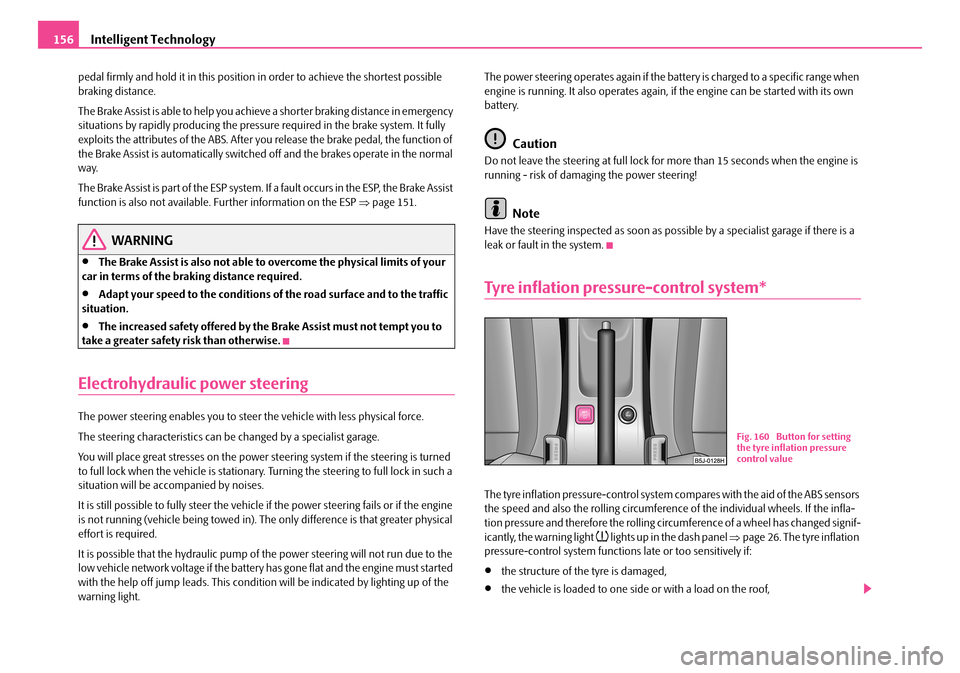
Intelligent Technology156
pedal firmly and hold it in this position in order to achieve the shortest possible braking distance.
The Brake Assist is able to help you achieve a shorter braking distance in emergency situations by rapidly producing the pressure required in the brake system. It fully exploits the attributes of the ABS. After you release the brake pedal, the function of the Brake Assist is automatically switched off and the brakes operate in the normal way.
The Brake Assist is part of the ESP system. If a fault occurs in the ESP, the Brake Assist function is also not available. Further information on the ESP ⇒page 151.
WARNING
•The Brake Assist is also not able to overcome the physical limits of your car in terms of the braking distance required.
•Adapt your speed to the conditions of the road surface and to the traffic situation.
•The increased safety offered by the Brake Assist must not tempt you to take a greater safety risk than otherwise.
Electrohydraulic power steering
The power steering enables you to steer the vehicle with less physical force.
The steering characteristics can be changed by a specialist garage.
You will place great stresses on the power steering system if the steering is turned to full lock when the vehicle is stationary. Turning the steering to full lock in such a situation will be accompanied by noises.
It is still possible to fully steer the vehicle if the power steering fails or if the engine is not running (vehicle being towed in). The only difference is that greater physical effort is required.
It is possible that the hydraulic pump of the power steering will not run due to the low vehicle network voltage if the battery has gone flat and the engine must started with the help off jump leads. This condition will be indicated by lighting up of the warning light.
The power steering operates again if the battery is charged to a specific range when engine is running. It also operates again, if the engine can be started with its own battery.
Caution
Do not leave the steering at full lock for more than 15 seconds when the engine is running - risk of damaging the power steering!
Note
Have the steering inspected as soon as possible by a specialist garage if there is a leak or fault in the system.
Tyre inflation pressure-control system*
The tyre inflation pressure-control system compares with the aid of the ABS sensors the speed and also the rolling circumference of the individual wheels. If the infla-tion pressure and therefore the rolling circumference of a wheel has changed signif-icantly, the warning light lights up in the dash panel ⇒page 26. The tyre inflation pressure-control system functions late or too sensitively if:
•the structure of the tyre is damaged,
•the vehicle is loaded to one side or with a load on the roof,
Fig. 160 Button for setting the tyre inflation pressure control value
NKO A05F 20.book Page 156 Wednesday, April 2, 2008 1:02 PM
Page 182 of 252
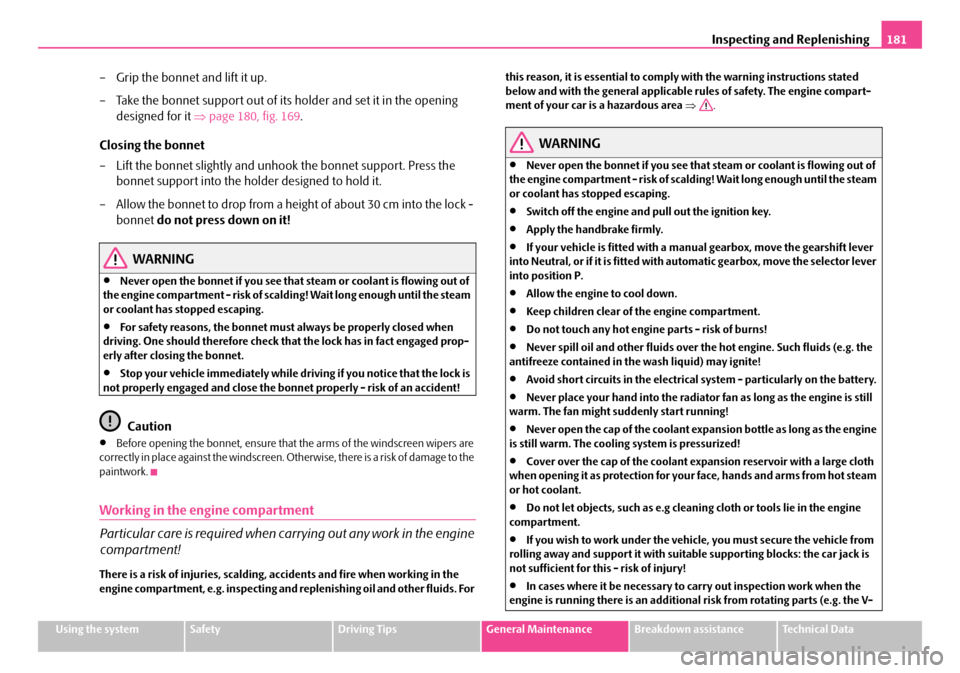
Inspecting and Replenishing181
Using the systemSafetyDriving TipsGeneral MaintenanceBreakdown assistanceTechnical Data
– Grip the bonnet and lift it up.
– Take the bonnet support out of its holder and set it in the opening
designed for it ⇒page 180, fig. 169.
Closing the bonnet
– Lift the bonnet slightly and unhook the bonnet support. Press the
bonnet support into the holder designed to hold it.
– Allow the bonnet to drop from a height of about 30 cm into the lock -
bonnet do not press down on it!
WARNING
•Never open the bonnet if you see that steam or coolant is flowing out of the engine compartment - risk of scalding! Wait long enough until the steam or coolant has stopped escaping.
•For safety reasons, the bonnet must always be properly closed when driving. One should therefore check that the lock has in fact engaged prop-erly after closing the bonnet.
•Stop your vehicle immediately while driving if you notice that the lock is not properly engaged and close the bonnet properly - risk of an accident!
Caution
•Before opening the bonnet, ensure that the arms of the windscreen wipers are correctly in place against the windscreen. Otherwise, there is a risk of damage to the paintwork.
Working in the engine compartment
Particular care is required when carrying out any work in the engine
compartment!
There is a risk of injuries, scalding, accidents and fire when working in the engine compartment, e.g. inspecting and replenishing oil and other fluids. For
this reason, it is essential to comply with the warning instructions stated below and with the general applicable rules of safety. The engine compart-ment of your car is a hazardous area ⇒.
WARNING
•Never open the bonnet if you see that steam or coolant is flowing out of the engine compartment - risk of scalding! Wait long enough until the steam or coolant has stopped escaping.
•Switch off the engine and pull out the ignition key.
•Apply the handbrake firmly.
•If your vehicle is fitted with a manual gearbox, move the gearshift lever into Neutral, or if it is fitted with automatic gearbox, move the selector lever into position P.
•Allow the engine to cool down.
•Keep children clear of the engine compartment.
•Do not touch any hot engine parts - risk of burns!
•Never spill oil and other fluids over the hot engine. Such fluids (e.g. the antifreeze contained in the wash liquid) may ignite!
•Avoid short circuits in the electrical system - particularly on the battery.
•Never place your hand into the radiator fan as long as the engine is still warm. The fan might suddenly start running!
•Never open the cap of the coolant expansion bottle as long as the engine is still warm. The cooling system is pressurized!
•Cover over the cap of the coolant expansion reservoir with a large cloth when opening it as protection for your face, hands and arms from hot steam or hot coolant.
•Do not let objects, such as e.g cleaning cloth or tools lie in the engine compartment.
•If you wish to work under the vehicle, you must secure the vehicle from rolling away and support it with suitable supporting blocks: the car jack is not sufficient for this - risk of injury!
•In cases where it be necessary to carry out inspection work when the engine is running there is an additional risk from rotating parts (e.g. the V-
NKO A05F 20.book Page 181 Wednesday, April 2, 2008 1:02 PM
Page 183 of 252
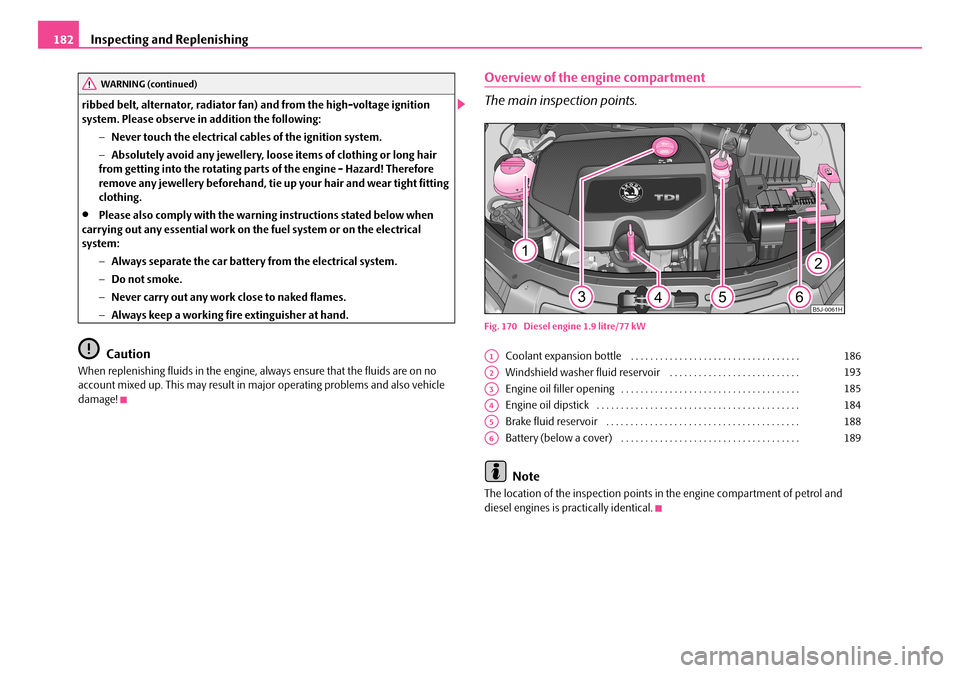
Inspecting and Replenishing182
ribbed belt, alternator, radiator fan) and from the high-voltage ignition system. Please observe in addition the following:
−Never touch the electrical cables of the ignition system.
−Absolutely avoid any jewellery, loose items of clothing or long hair from getting into the rotating parts of the engine - Hazard! Therefore remove any jewellery beforehand, tie up your hair and wear tight fitting clothing.
•Please also comply with the warning instructions stated below when carrying out any essential work on the fuel system or on the electrical system:
−Always separate the car battery from the electrical system.
−Do not smoke.
−Never carry out any work close to naked flames.
−Always keep a working fire extinguisher at hand.
Caution
When replenishing fluids in the engine, always ensure that the fluids are on no account mixed up. This may result in major operating problems and also vehicle damage!
Overview of the engine compartment
The main inspection points.
Fig. 170 Diesel engine 1.9 litre/77 kW
Coolant expansion bottle . . . . . . . . . . . . . . . . . . . . . . . . . . . . . . . . . . .
Windshield washer fluid reservoir . . . . . . . . . . . . . . . . . . . . . . . . . . .
Engine oil filler opening . . . . . . . . . . . . . . . . . . . . . . . . . . . . . . . . . . . . .
Engine oil dipstick . . . . . . . . . . . . . . . . . . . . . . . . . . . . . . . . . . . . . . . . . .
Brake fluid reservoir . . . . . . . . . . . . . . . . . . . . . . . . . . . . . . . . . . . . . . . .
Battery (below a cover) . . . . . . . . . . . . . . . . . . . . . . . . . . . . . . . . . . . . .
Note
The location of the inspection points in the engine compartment of petrol and diesel engines is practically identical.
WARNING (continued)
B5J-0061H
A1186
A2193
A3185
A4184
A5188
A6189
NKO A05F 20.book Page 182 Wednesday, April 2, 2008 1:02 PM
Page 190 of 252

Inspecting and Replenishing189
Using the systemSafetyDriving TipsGeneral MaintenanceBreakdown assistanceTechnical Data
One may only use new genuine brake fluid from Škoda Auto a.s. The specification for the brake fluid is “FMVSS 116 DOT 4”.
We recommend that you have the brake fluid replaced by a Škoda Service Partner as part of an Inspection Service.
WARNING
•Using old brake fluid can result in severe stress on the brakes because of the formation of vapour bubbles in the brake system. This greatly impairs the braking efficiency and thus also the safety of your vehicle.
•Brake fluid is toxic! It must therefore be kept safely in closed original containers and well away from children and unauthorized persons.
Caution
Brake fluid damages the paintwork of the vehicle.
For the sake of the environment
In view of the problems involved with proper disposal of brake fluid, the special tools and the professional knowledge required, we recommend you have the brake fluid replaced by a Škoda Service Partner.
Battery
Working on the battery
The battery is located in the engine compartment below a plastic box.
– Unlock the interlock on the positive terminal side of the battery
⇒fig. 174.
– Open the cover in direction of arrow.
– The installation of the battery cover on the positive terminal side takes
place in the reverse order.
Removal and installation of the battery is not recommended since it can, under certain circumstances, lead to major damage to the battery and fuse boxes. Contact a specialist garage.
There is a risk of injuries, scalding, accidents and burns when carrying out any work on the battery and on the electrical system. For this reason, it is essential to comply with the warning instructions ⇒ stated below and with the general applicable rules of safety.
Fig. 174 The battery: Open up the cover
NKO A05F 20.book Page 189 Wednesday, April 2, 2008 1:02 PM
Page 191 of 252
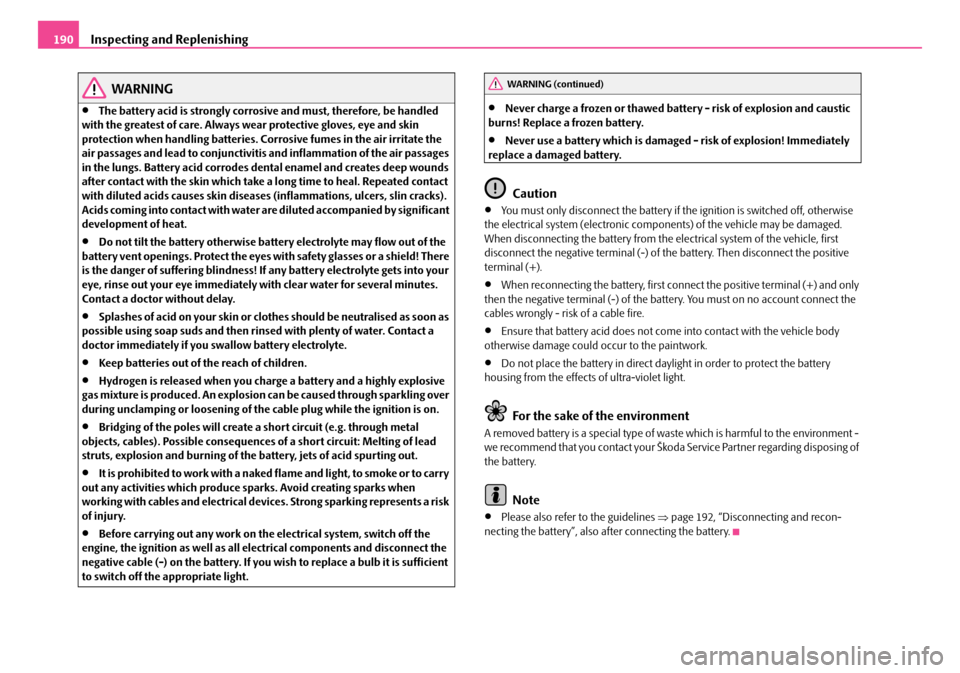
Inspecting and Replenishing190
WARNING
•The battery acid is strongly corrosive and must, therefore, be handled with the greatest of care. Always wear protective gloves, eye and skin protection when handling batteries. Corrosive fumes in the air irritate the air passages and lead to conjunctivitis and inflammation of the air passages in the lungs. Battery acid corrodes dental enamel and creates deep wounds after contact with the skin which take a long time to heal. Repeated contact with diluted acids causes skin diseases (inflammations, ulcers, slin cracks). Acids coming into contact with water are diluted accompanied by significant development of heat.
•Do not tilt the battery otherwise battery electrolyte may flow out of the battery vent openings. Protect the eyes with safety glasses or a shield! There is the danger of suffering blindness! If any battery electrolyte gets into your eye, rinse out your eye immediately with clear water for several minutes. Contact a doctor without delay.
•Splashes of acid on your skin or clothes should be neutralised as soon as possible using soap suds and then rinsed with plenty of water. Contact a doctor immediately if you swallow battery electrolyte.
•Keep batteries out of the reach of children.
•Hydrogen is released when you charge a battery and a highly explosive gas mixture is produced. An explosion can be caused through sparkling over during unclamping or loosening of the cable plug while the ignition is on.
•Bridging of the poles will create a short circuit (e.g. through metal objects, cables). Possible consequences of a short circuit: Melting of lead struts, explosion and burning of the battery, jets of acid spurting out.
•It is prohibited to work with a naked flame and light, to smoke or to carry out any activities which produce sparks. Avoid creating sparks when working with cables and electrical devices. Strong sparking represents a risk of injury.
•Before carrying out any work on the electrical system, switch off the engine, the ignition as well as all electrical components and disconnect the negative cable (-) on the battery. If you wish to replace a bulb it is sufficient to switch off the appropriate light.
•Never charge a frozen or thawed battery - risk of explosion and caustic burns! Replace a frozen battery.
•Never use a battery which is damaged - risk of explosion! Immediately replace a damaged battery.
Caution
•You must only disconnect the battery if the ignition is switched off, otherwise the electrical system (electronic components) of the vehicle may be damaged. When disconnecting the battery from the electrical system of the vehicle, first disconnect the negative terminal (-) of the battery. Then disconnect the positive terminal (+).
•When reconnecting the battery, first connect the positive terminal (+) and only then the negative terminal (-) of the battery. You must on no account connect the cables wrongly - risk of a cable fire.
•Ensure that battery acid does not come into contact with the vehicle body otherwise damage could occur to the paintwork.
•Do not place the battery in direct daylight in order to protect the battery housing from the effects of ultra-violet light.
For the sake of the environment
A removed battery is a special type of waste which is harmful to the environment - we recommend that you contact your Škoda Service Partner regarding disposing of the battery.
Note
•Please also refer to the guidelines ⇒page 192, “Disconnecting and recon-necting the battery”, also after connecting the battery.
WARNING (continued)
NKO A05F 20.book Page 190 Wednesday, April 2, 2008 1:02 PM
Page 192 of 252

Inspecting and Replenishing191
Using the systemSafetyDriving TipsGeneral MaintenanceBreakdown assistanceTechnical Data
Battery with a charge level indicator, the so-called magic eye*
There is a so-called magic eye ⇒fig. 175 located on the top of the battery. The “magic eye” changes its colour in line with the charge state of and electrolyte level in the battery.
Air bubbles can influence the colour of the “magic eye”. For this reason carefully knock on the “magic eye” before carrying out the check.
•Green colour - the battery is adequately charged.
•Dark colour - the battery has to be charged
•Colourless or yellow colour - we recommend you have the battery checked by a Škoda Service Partner.
Batteries, which are more than 5 years old, must be replaced. We recommend you have the electrolyte level inspected and adjusted to the correct level or the battery replaced if necessary by a Škoda Service Partner.
Caution
If the vehicle has not been driven for more than 3 to 4 weeks, the battery will discharge because certain electrical components consume electricity (e.g. control units) also in idle state. You can prevent the discharging of the battery by discon-necting the negative terminal or charging the battery constantly with a very low charging current. Please also refer to the notes when working on the battery ⇒page 189, “Working on the battery”.
Inspecting the electrolyte level
The battery is practically maintenance-free under normal operating conditions. We do, however, recommend that you have the electrolyte level inspected from time to time by a Škoda Service Partner when outside temperatures are high or when driving on long trips. You should also check the electrolyte level ⇒page 191 each time the battery is charged.
The battery acid level will also be checked as part of the Inspection Service.
Operation in winter
The battery has to provide greater amounts of electricity during the winter. It also has only part of the initial power output at low temperatures that it has at normal temperatures.
A discharged battery may already freeze at temperatures just below 0°C.
We therefore recommend that you have the battery checked by a Škoda Service Partner before the start of the winter, and recharged if necessary.
Charging the battery
A properly charged battery is essential for reliably starting the
engine.
– Read the warning notes ⇒ in “Working on the battery” on
page 189 and ⇒.
– Switch the ignition and all electrical components off.
– Only for “quick-charging”: Disconnect both battery cables (first of all
“negative”, then “positive”).
– Carefully attach the terminal clamps of the charger to the battery
terminals (red = “positive”, black = “negative”).
– You can now plug the mains cable of the charger into the power socket
and switch on the charger.
Fig. 175 Battery with a charge level indicator
NKO A05F 20.book Page 191 Wednesday, April 2, 2008 1:02 PM
Page 193 of 252
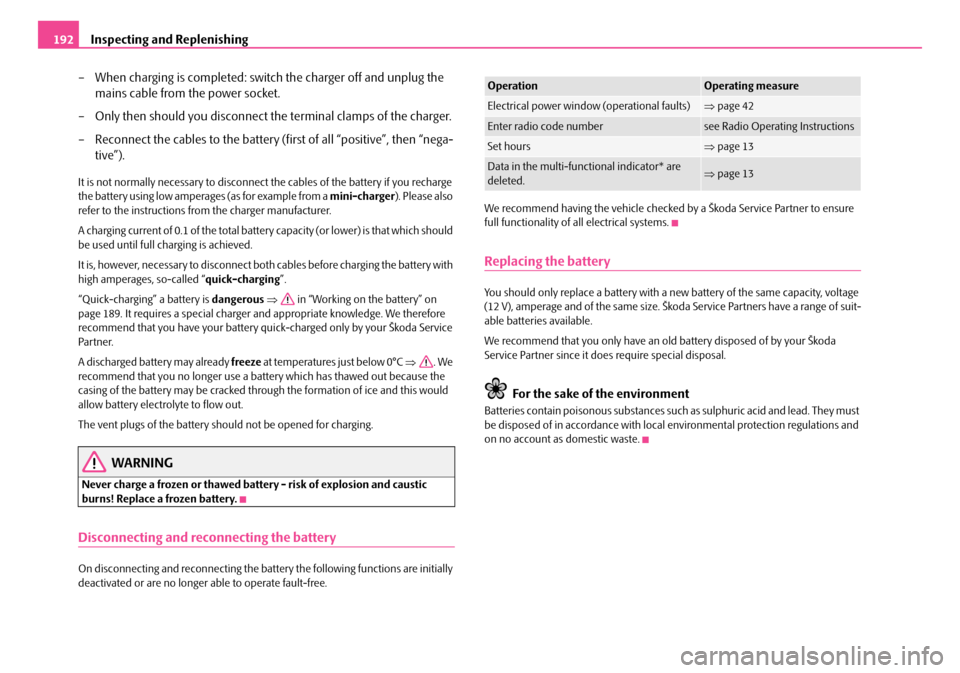
Inspecting and Replenishing192
– When charging is completed: switch the charger off and unplug the
mains cable from the power socket.
– Only then should you disconnect the terminal clamps of the charger.
– Reconnect the cables to the battery (first of all “positive”, then “nega-
tive”).
It is not normally necessary to disconnect the cables of the battery if you recharge the battery using low amperages (as for example from a mini-charger). Please also refer to the instructions from the charger manufacturer.
A charging current of 0.1 of the total battery capacity (or lower) is that which should be used until full charging is achieved.
It is, however, necessary to disconnect both cables before charging the battery with high amperages, so-called “quick-charging”.
“Quick-charging” a battery is dangerous ⇒ in “Working on the battery” on page 189. It requires a special charger and appropriate knowledge. We therefore recommend that you have your battery quick-charged only by your Škoda Service Par tner.
A discharged battery may already freeze at temperatures just below 0°C ⇒. We recommend that you no longer use a battery which has thawed out because the casing of the battery may be cracked through the formation of ice and this would allow battery electrolyte to flow out.
The vent plugs of the battery should not be opened for charging.
WARNING
Never charge a frozen or thawed battery - risk of explosion and caustic burns! Replace a frozen battery.
Disconnecting and reconnecting the battery
On disconnecting and reconnecting the battery the following functions are initially deactivated or are no longer able to operate fault-free.
We recommend having the vehicle checked by a Škoda Service Partner to ensure full functionality of all electrical systems.
Replacing the battery
You should only replace a battery with a new battery of the same capacity, voltage (12 V), amperage and of the same size. Škoda Service Partners have a range of suit-able batteries available.
We recommend that you only have an old battery disposed of by your Škoda Service Partner since it does require special disposal.
For the sake of the environment
Batteries contain poisonous substances such as sulphuric acid and lead. They must be disposed of in accordance with local environmental protection regulations and on no account as domestic waste.
OperationOperating measure
Electrical power window (operational faults)⇒page 42
Enter radio code numbersee Radio Operating Instructions
Set hours⇒page 13
Data in the multi-functional indicator* are deleted.⇒page 13
NKO A05F 20.book Page 192 Wednesday, April 2, 2008 1:02 PM
Page 209 of 252
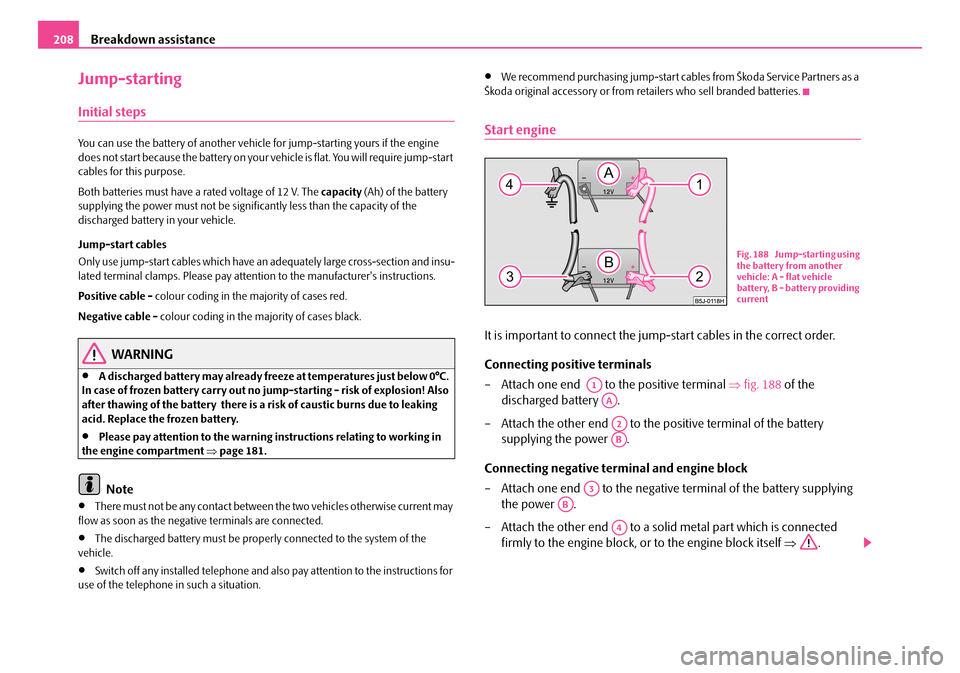
Breakdown assistance208
Jump-starting
Initial steps
You can use the battery of another vehicle for jump-starting yours if the engine does not start because the battery on your vehicle is flat. You will require jump-start cables for this purpose.
Both batteries must have a rated voltage of 12 V. The capacity (Ah) of the battery supplying the power must not be significantly less than the capacity of the discharged battery in your vehicle.
Jump-start cables
Only use jump-start cables which have an adequately large cross-section and insu-lated terminal clamps. Please pay attention to the manufacturer's instructions.
Positive cable - colour coding in the majority of cases red.
Negative cable - colour coding in the majority of cases black.
WARNING
•A discharged battery may already freeze at temperatures just below 0°C. In case of frozen battery carry out no jump-starting - risk of explosion! Also after thawing of the battery there is a risk of caustic burns due to leaking acid. Replace the frozen battery.
•Please pay attention to the warning instructions relating to working in the engine compartment ⇒page 181.
Note
•There must not be any contact between the two vehicles otherwise current may flow as soon as the negative terminals are connected.
•The discharged battery must be properly connected to the system of the vehicle.
•Switch off any installed telephone and also pay attention to the instructions for use of the telephone in such a situation.
•We recommend purchasing jump-start cables from Škoda Service Partners as a Škoda original accessory or from retailers who sell branded batteries.
Start engine
It is important to connect the jump-start cables in the correct order.
Connecting positive terminals
– Attach one end to the positive terminal ⇒fig. 188 of the
discharged battery .
– Attach the other end to the positive terminal of the battery
supplying the power .
Connecting negative terminal and engine block
– Attach one end to the negative terminal of the battery supplying
the power .
– Attach the other end to a solid metal part which is connected
firmly to the engine block, or to the engine block itself ⇒.
Fig. 188 Jump-starting using the battery from another vehicle: A - flat vehicle battery, B - battery providing current
A1
AA
A2
AB
A3
AB
A4
NKO A05F 20.book Page 208 Wednesday, April 2, 2008 1:02 PM